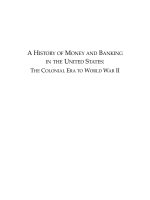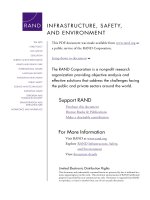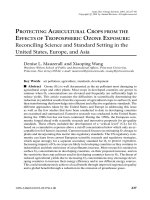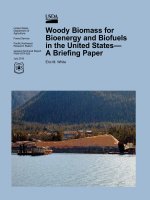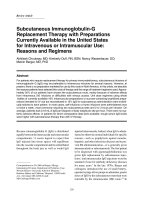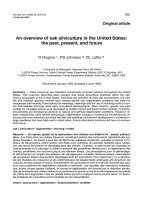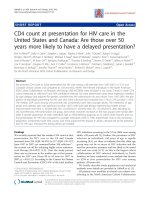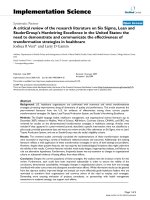TEACHER TRAINING AND DEVELOPMENT IN THE UNITED STATES - Full 10 điểm
Bạn đang xem bản rút gọn của tài liệu. Xem và tải ngay bản đầy đủ của tài liệu tại đây (598.63 KB, 27 trang )
N. H. Quyet, F. A. Biafora / Teacher training and development in the United States
TEACHER TRAINING AND DEVELOPMENT
IN THE UNITED STATES
Nguyen Huu Quyet (1), Frank A. Biafora (2)
1 Department of Foreign Languages, Vinh University
2 University of South Florida, USA
Received on 15/12/2017, accepted for publication on 21/4/2018
Abstract: This report attempts to offer fundamentals in teacher training and
development in the United States. The report is structured around the following five
components designed in the form of questionnaires: (1) Teacher education programs
which involve entry requirements, training curriculum, and exit standards; (2) teacher
certification requirements; (3) teacher recruitment requirements; (4) continuing
education and support for beginning teachers; and (5) providers and governance of
teacher education and certification. One of the most striking findings is that while entry
requirements for teacher education are flexible, if not downplaying, across the states,
the curriculum places a particular focus on the subject area content courses and, more
importantly, on coursework in education and pedagogical skills, together with a long
period of in-school student teaching, as prerequisites for graduation. Let alone such
practice-based exit requirements, the quality of prospective teachers is checked upon
by teacher licensure testing and further empowered by regular induction programs and
professional development with an ultimate goal of meeting the eleven professional
standards for teachers. With these, the report reveals systematic differences in the
practices of teacher education programs, certification, and professional development,
among other things, in the United States as compared with those in Vietnam. Thus, it
may leave some room for consideration.
INTRODUCTION has been made to bring about changes in
the aforementioned issues, it is hard,
Over almost the past two decades, however, to define a typical framework
significant attention has been given to that involves similarities in teacher
U.S. states’ policies governing the supply education in the United States since
and quality of teachers. Strong debate, program specifics and requirements vary
together with legislative initiatives, has widely within the context of each state
focused on the entry requirements and and academic institutions.
higher standards, the need for nationwide
standards in licensure testing, the quality This report endeavors to provide
of teacher education programs, alternate fundamentals in teacher training and
routes into teaching, academic development in the United States. The
requirements, induction programs and report gears its priority to the analysis of
hiring, etc. In one way or another, any one five components that help address the
of these issues has been viewed as a root relevant questions of concern about
cause or possible solution to the teacher preparation in U.S. higher
inadequate teacher quality and consequent education. These include teacher
student performance. Thus far much effort education programs, teacher certification,
Email: (N. H. Quyet)
30
Trường Đại học Vinh Tạp chí khoa học, Tập 47, Số 1B (2018), tr. 30-56
teacher recruitment requirements, popular in states that fall far short of
continuing education and support for teachers.
beginning teachers, and providers and
governance of teacher education and For graduate Level
certification.
What are the requirements for entry
1. TEACHER EDUCATION into graduate teacher education
programs?
1.1. Entry Requirements
Graduate-level teacher education
For undergraduate Level programs in the United States generally
require at least a bachelor’s degree in
What are the requirements for entry education. Organizations responsible for
into undergraduate teacher education reviewing and approving teacher
programs? education curriculum belong to
independent national organizations and
There is wide variation across U.S. state statutory committees. Other
states and higher education institutions in admission requirements may include state
entry standards for undergraduate certification in elementary, middle
education programs and in their level, or secondary education, evidence
enforcement. In some instances students for active engagement in classroom
may begin teacher education coursework teaching, letters of recommendations, and
upon enrolling at the undergraduate a minimum undergraduate grade point
institution. In other cases, prospective average (GPA) of 2.5, or 3.0, overall and
education students must complete two 3.0 in the academic major. In case,
years of general or liberal arts studies and candidates who did not earn an adequate
then apply for admission into the teacher GPA in their major in undergraduate
education program. Some institutions programs will be asked to complete
require a minimum college general point additional courses in that major at host
average (GPA) or high school record. In institutions.
addition, prospective students have to
pass computer-based basic academic tests, 1.2. Teacher Education Curriculum
known as Praxis I, to measure academic
skills in reading, writing and What courses or curriculum are
mathematics. These tests are designed to required in teacher education programs?
provide comprehensive assessments that What is the balance between subject area
measure the skills and content knowledge content courses and courses in education
of candidates before entering teacher and pedagogy? What are the differences
preparation programs. In fact, a recent between undergraduate and graduate
survey found that a majority of states programs? Who determines the
require an exam for entry (Educator requirements?
Recruitment & Retention Task Force,
2015). A few states, apart from Praxis I In the United States, the curriculum
tests, may require recommendations, content of teacher education programs is
interviews, and experience working with determined by individual teacher training
learners as requirements for entry. institutions, within the context of state
However, these requirements are not and national accreditation policies. There
are similarities across institutions,
31
N. H. Quyet, F. A. Biafora / Teacher training and development in the United States
however. In addition to subject area - Instructional Assessment;
content courses, institutions typically - Instructional Technology;
require coursework on education theory - Integrated Literacy;
and pedagogy, and student teaching - Introduction to Teacher Certification;
experience. Courses in special education, - Pedagogy of Language Arts;
health and nutrition, and computer - Pedagogy of Math;
science may also be required. - Pedagogy of Reading;
- Pedagogy of Science;
A typical undergraduate teacher - Pedagogy of Social Studies;
education program might consist of 120 - Primary Education;
credit hours (the average required for - Schooling in America;
graduation from most undergraduate - Supervised Demonstration Teaching;
liberal arts programs), or 134 credits - Elementary and middle school
(required to complete an undergraduate education or secondary education;
teacher education program). On average, - Teaching Special Populations.
51 credits of general studies, 38 credits of In addition to courses that relate to
major credits (includes courses in candidates’ major and minor, coursework
certification teaching subject area), 28 on education and pedagogical skills is
credits of professional studies (includes required. The specific classes students
school, college, or department of need to take will depend on whether they
education courses), and 14 clinical credit are getting certified in elementary,
hours (includes student teaching and other middle, secondary, postsecondary, special
field-based experiences) are required to education, or another area. Regardless of
complete initial preparation for school the type of certification, there are certain
teaching. The curriculum is accredited by types of coursework that every
independent national organizations and prospective teacher needs to take:
state statutory committees. - Learner’s development or
psychology: These courses will help
Typical courses in a teacher future teachers better understand the
preparation program are listed as follows: minds of learners and how they develop;
- Curriculum and instructional design:
- Advanced Processes and Acquisition These courses will help future teachers
of Reading; how to develop and write curricula and
lesson plans for their classes;
- Best Practices in Teaching; - Methods: Teaching methods courses
- Student Care Management & Admin; focus on the practice of teaching or
- Classroom Management; pedagogy, including how to explain and
- Clinical Practice; demonstrate concepts, how to lecture, and
- Clinical Teaching; how to hold an effective discussion;
- Cultural Perspectives in Education; - Assessment: In courses on
- Diagnosing and Correcting Reading assessment practices, prospective teachers
Difficulties; will learn how to assess student learning
- Discipline and Classroom by creating tests, using oral exams,
Management; designing projects, and other techniques;
- Educating Exceptional Students;
- Educational Psychology;
- Foundations for Early Childhood
Development;
- Human Growth and Development;
32
Trường Đại học Vinh Tạp chí khoa học, Tập 47, Số 1B (2018), tr. 30-56
- Special Education: Whether or not prerequisites for student teaching may
prospective teachers are pursuing special include the completion of specific subject
education certification, they will likely be area content courses and coursework, and
required to take some coursework in this an adequate GPA. A university faculty
area. Even general education teachers member and a classroom teacher, or the
must understand special education to school principal, typically supervises a
some extent. student teacher. Student teachers may first
spend time in the school observing classes
For master’s students, they may be and assisting teachers. They are then
required to research and present a project, paired with an experienced teacher, who
while at the same time taking courses that likely is paid for assuming the
teach wide skill set, including: supervisory role. Student teaching
evaluation practices also vary by state, but
- Education philosophy; are typically shared among several
- Learning and cognition; individuals, including a university faculty
- Psychology of teaching; member, an experienced teacher, and
- Critical thinking; sometimes the principal of the school.
- Instructional proficiency;
- Curriculum theory and development. 1.3. Exit Requirements
Student teaching experience What requirements must be met to
complete the teacher education program?
What kinds of classroom experiences Who determines these requirements?
are required? What is the nature and
duration of these requirements? In the United States, exit standards
for teacher education programs vary by
In the United States, all teacher state and institution, and are generally
programs include practical teaching determined at the institutional level. By
experience as a final component in looking at the curriculum, exit standards
teacher education curriculum, often typically are also required to include such
completed during the final year of study. things as an adequate GPA, completion of
The required duration of the student required subject area content courses and
teaching experience varies by state as coursework, and student teaching. For
well as by the type of teaching license the master’s students, apart from these
candidate wishes to pursue. However, requirements, they may, depending on
nearly all programs will require at least each state and respective institution, have
one semester (15 weeks) of student to research and present a project and have
teaching and program specifics vary by an adequate GPA of the required
state and institution. Some institutions coursework for mater’s program as
may require a full year at one school discussed previously.
(CAEP, 2013a).
2. TEACHER CERTIFICATION
There are two types of practical
experiences for teacher candidates: field 2.1. Initial Certification
experiences and student teaching or other
in-school practical experiences. Field What are the requirements for the
experiences normally consist solely of initial certification of teachers? Are tests
observations and are required by most
states prior to student teaching. Other
33
N. H. Quyet, F. A. Biafora / Teacher training and development in the United States
used? Who sets the standards? For how two years. In some states, the professional
long is the certificate valid? certificate is not renewable. After
expiration, teachers must apply for a
With all the exit standards already in standard or regular certificate and face
place, candidates cannot enter the additional requirements-usually some
teaching profession at any level unless type of performance-based assessment
they get certified by their respective state and a specified number of classroom
through the passage of a teacher licensing teaching hours.
examination, which is known as Initial
Certification. Most states award a 2.2. Advanced Certification
professional teaching certificate after
completion of an approved program of Is certification beyond the initial level
required courses, student teaching available? Is it required or voluntary?
experiences, criminal background checks, How is it obtained? What incentives are
and successful passage of the state teacher offered for teachers who pursue advanced
licensing examination. States set their certificates?
own cut scores on these examinations.
The teacher licensing exam used by most Advanced certification in the United
states is the Praxis Series-the Professional States is voluntary, offered by the
Assessments for Beginning Teachers National Board for Professional Teaching
developed by the Educational Testing Standards (NBPTS), a voluntary
Service. In most states, the Praxis Series professional certification board. Key
for initial certification consists of two components include candidate’s assembly
parts to measure comprehensive of a portfolio and participation in on-
assessment of teaching candidates’ demand tasks at assessment centers. Some
standards: an academic skills assessment states also offer a master teacher
(Praxis I), known as the General certificate, a voluntary certification issued
Knowledge Tests, which measure to teachers demonstrating advanced
knowledge and skills in essay writing, the competency and achievement. In some
English language, reading, and jurisdictions, NBPTS certification may be
mathematics; an assessment of content a prerequisite for a master teacher
knowledge (Praxis II), known as the certification. This type of advanced
Subject Area Test, specific to the content certificate is usually held in conjunction
area(s) in which the candidate desires to with a professional license and often
teach (Masters, G., 2012). In some states, extends the validity of the professional
prospective teachers may also required to license. Master teachers often provide
take the Professional Education Exam mentoring to other teachers and play roles
(Praxis III), which measures pedagogical in curriculum development and other
knowledge such as lesson planning and leadership activities.
the selection of appropriate evaluation
instruments. Incentives for achieving advanced
certification vary by state, but usually
Once all exams have been include salary increases or bonuses and
successfully passed and all other promotions.
requirements as mentioned above have
been met, the candidate can qualify for 2.3. Alternative Certification
the Initial Certificate, typically valid for
Are there ways for individuals to
become teachers outside of traditional
34
Trường Đại học Vinh Tạp chí khoa học, Tập 47, Số 1B (2018), tr. 30-56
teacher education programs? How do student development or psychology,
these operate? curriculum and instructional design,
methods, assessment, and special
In response to critical teacher education as mentioned previously)
shortages in the United States, often in before a teaching credential is issued.
low-income school districts and in certain
fields, all states and the District of Alternative teacher certification
Columbia offer alternative teacher programs are growing in popularity. For
certification programs. According to a example, in states such as Texas and
2012 survey by the National Center for California nearly one-third of their new
Education Statistics (NCES), 14.6% of teachers and in New Jersey over 40% of
teachers leading classrooms in public new teachers are prepared in alternative
schools entered teaching through an route programs (NCEI, 2009). According
alternative pathway (NCES, 2014). The to the report of National Center for
alternative certification route typically Alternative Certification (NCAC), in
provides on-the-job training to college 2010, there were approximately 600
graduates who are placed in teaching jobs alternate route teacher preparation
and offered the necessary coursework, programs in 48 states and the District of
support, time, and supervision required Colombia, and over 500,000 teachers
for full certification. This training ranges graduated from alternate route programs
from intensive summer programs to year- since 1980 (NCAC, 2010). This tendency
round programs that mirror regular presented the direct result of many states’
teacher education programs. In many growing demand to use them to increase
cases, eligible candidates can also their pool of teachers from under-
complete the teacher preparation represented cultural groups; meet the
alternative certification online and receive staffing needs of urban and high-poverty
interactive tutoring and support from schools; and attract mid-career
experienced professionals in the field of professionals to teaching by avoiding the
education. Online preparation programs lengthy and arguably cumbersome
have grown more and more popular, with certification process. A number of such
over 6,000 new educators graduating programs exist, such as Teach for
from online programs each year (USA America, Troops to Teachers, and
Today, August 8, 2012). Most often, Transition to Teaching.
prospective teachers pursuing alternative
certification have a bachelor’s degree in a 3. TEACHER RECRUITMENT
subject area (not in education), such as REQUIREMENTS
science, technology, engineering and
mathematics (STEM), but have neither Who is responsible for recruiting
taken any education courses nor done any teachers? What are the criteria?
student teaching. Requirements for full
licensure vary widely across states, In the United States, schools and
depending on regional needs and local school districts are responsible for
resources. However, most states require recruiting and hiring teachers. The size of
that alternative route candidates achieve a these schools and school districts ranges
passing score on state examinations and from very small to very large, resulting in
take additional coursework (composed of great differences in hiring needs and
hiring processes. The system for
recruiting and hiring teachers is not
35
N. H. Quyet, F. A. Biafora / Teacher training and development in the United States
universal and has been characterized as new teacher support with some dedicated
fragmented by policy bodies like the funding for teacher induction programs
National Commission for Teaching and and a majority of states have policies in
America’s Future. The most common place to structure or guide teacher-mentor
hiring criteria are completion of an selection. Twenty-three states require or
appropriate university degree (also encourage release time for mentor
including an adequate GPA of subject teachers to conduct classroom
area content courses and coursework as observations and provide support during
well as student teaching experience), the school day. Twelve states establish a
subject matter specialization, professional minimum amount of weekly or annual
certificate or equivalent, demonstration of mentor contact time for beginning
communication skills, proper attitude, and teachers. Most induction programs
interviews. address three key elements: (1) classroom
observations of and by beginning
In most states, upon having been teachers; (2) formative assessment of or
recruited, teachers earn the right, after an feedback on teaching from mentors; and
average probationary period of three (3) participation in a professional learning
years, to continue teaching in their school community or beginning educator peer
districts. It is very difficult to terminate a network. Though induction programs for
tenured teacher, and this action usually new teachers are voluntary, twenty-four
requires proof of misconduct (Wixom, states require new teachers to complete or
2016). participate in an induction or mentoring
program for professional teaching
4. CONTINUING EDUCATION certification (NTC, 2016).
AND SUPPORT
4.2. Professional Development
4.1. Beginning Teacher Induction
Are there additional educational
Are there support programs for new
teachers? How do they operate? programs or opportunities for practicing
In much of the United States, new teachers? Are they required or voluntary?
teachers become oriented to their school
when they first start teaching. These Are there incentives for participation?
orientations tend to last, at the most, a few
days on a periodical basis throughout the In the United States, some states issue
year. Many school districts also offer
structured support programs for beginning a life teaching credential, and all
or first year teachers. These systematic
efforts to support beginning teachers are professional development after that is up
known as induction programs and may
involve a mentor or experienced teacher to the employer and/or the certificated
working with the beginning teacher.
staff member. Other states issue a
There is a wide variety in induction
program policies and components, permanent credential that must be verified
however. According to a recent policy
report conducted by New Teacher Center periodically by the employer to ensure
(NTC), 27 states required some type of
that the teacher has met the school
district’s professional development
requirements. Other states require
verification of professional development
for renewal of the certificate.
For decades, professional
development programs in the United
States largely have been organized by
36
Trường Đại học Vinh Tạp chí khoa học, Tập 47, Số 1B (2018), tr. 30-56
individual schools or districts and, teacher preparation, district induction
programs, professional development
typically, in the form of workshops programs, and the school district teacher
evaluation. This system aligns with 11
scattered throughout the school year, on a standards which are typically grouped
into the following four domains: The
wide variety of topics. In some districts Learner and Learning (Standards One,
Two, and Three); Content Knowledge
and states, workshops might precede the (Standards Four and Five); Instructional
Practice (Standards Six, Seven, and
school year, particularly when a major Eight); and Professional Responsibility
(Standards Nine, Ten, and Eleven). The
new program is being introduced. A elements of each standard are divided into
three categories: Performances, Essential
recent NCES survey of teachers on their Knowledge, and Critical Dispositions (see
Index for details).
professional development activities
5. PROVIDER AND GOVERNANCE
discovered the following topics, such as OF TEACHER EDUCATION AND
CERTIFICATION
curriculum and performance standards,
Who is responsible for teacher
with educational technology integration, education and certification? What aspects
are regulated?
subject-area study, new instructional
Across the states in the United States,
methods, and student performance teacher education programs are provided
by multidisciplinary institutions within
assessment being the next most popular which, typically, a college of education is
an affiliate though are a small number of
topics. Other common professional only-teacher education institutions.
According to the Council for the
development topics concerned addressing Accreditation of Educator Preparation
(CAEP), as of 2011, there had been 1,624
the needs of disabled or limited-English educator preparation providers (CAEP,
2013b). Most are four-year undergraduate
proficient students, encouraging programs, but some five-year programs
exist that add a fifth year to a standard
community involvement, classroom undergraduate liberal arts program.
Colleges of education are accredited as
management and student discipline, well as governed by accreditation
authorities for teacher education and
addressing the needs of students of certification. However, the United States
has a decentralized system of teacher
diverse backgrounds, engaging education and certification, in that each
state is responsible for initial
experienced teachers in professional credentialing of its teachers. Some states
development activities concerning in-
depth study of their subject area or
classroom management, program
improvement activities to a moderate or
great extent, school administration
support in applying what was learned to a
moderate or great extent, additional
training to a moderate or great extent, and
teaching initiatives to use to a moderate or
great extent, etc (NCES, 2016).
4.3. Professional Standards for
Teachers
How many professional standards for
school teachers? What domains are
involved? How is each standard
categorized?
In the United States, with a view to
ensuring the quality of school teachers, a
rubrics system of professional standards
for teachers is established, involving
37
N. H. Quyet, F. A. Biafora / Teacher training and development in the United States
refer to this initial credential process as five aforementioned components have
certification. Certification requirements been made and contributed greatly to the
vary greatly across the states, depending improvement of teacher education and
on local needs and available resources. training, and, respectively, in-school
However, there are probably more student performance over the past decade,
commonalities than differences in state especially since President Obama’s
teacher education and certification Educational Reform Plan commencing in
systems. This is in part due to the fact that 2010.1 Of a particular note to such a
during 2013, the National Council for development are a practice-based
Accreditation of Teacher Education curriculum, higher exit standards, teacher-
(NCATE) and the Teacher Education quality licensure testing and regular
Accreditation Council (TEAC) became induction programs as well as
the new unified accrediting body for professional development, which, taken
educator preparation, the Council for the together, align with the eleven
Accreditation of Educator Preparation professional standards for teachers.
(CAEP) recognized by the U.S.
Department of Education. As the As part of the search for successful
accreditor for educator preparation approaches to teacher education and
providers, CAEP is accountable to the training in the United States, it may be
public, the states, policymakers, and helpful for Vietnamese institutions of
professionals in the field of educator education to learn some extent from the
(CAEP, 2013b). These accreditation U.S. teacher education models in place.
authorities specify frameworks such as This involves creative and energetic
standards for entry and exit, the required solutions that need to begin soon and be
areas of study, professional skills to be sustained for many years to come. Urgent
addressed, and the minimum number of steps to be taken lie in reconsideration of
days of practicum. Successful completion the existing training curriculum, duration
of such a course then allows the graduate of prospective teachers’ internship, exit
to be registered or licensed to enter the requirements, certification, and teachers’
teaching profession. However, additional professional development in Vietnamese
requirements for registration or licensure, institutions of education.
including standardized tests, have been in
place in the US for a considerable time
(Mawdsley and Cumming, 2011: 25).
CONCLUSION 1 Author’s interview with Jenifer Hartman, Ed. D.,
Assistant Professor, Educational Leadership
Ensuring the quality of teachers has Program, College of Education at University of
been one of the focal points on the U.S. South Florida St. Petersburg, dated 11 October,
educational policy-making agenda. This 2017.
great need did call into question the status
of teacher education programs,
certification, professional development,
teacher compensation policy, and
governing bodies of teacher education and
certification. As a result, changes in the
38
Trường Đại học Vinh Tạp chí khoa học, Tập 47, Số 1B (2018), tr. 30-56
REFERENCES
[1] CAEP (2013a), Annual Report to the public, the states, policymakers, and the
education profession. Washington, DC: Council for the Accreditation of Educator
Preparation. Available at < /> final.pdf>.
[2] CAEP (2013b), Policy Manual. Washington, DC: Council for the Accreditation of
Educator Preparation, CAEP Website. Available at
[3] Educator Recruitment & Retention Task Force, Education Retention and Recruitment
Report, prepared by the Arizona Department of Education Educator Retention and
Recruitment Task Force, January 2015. Available at < /> content/uploads/2015/02/err-initial-report-final.pdf>.
[4] Masters G. (2012), Enhancing the Quality of Teaching and Learning in Australian
Schools, Australian Council for Educational Research (ACER), Available at
< />
[5] Mawdsley R. & Cumming J., Certification of Teachers, Pre-Service Teacher
Education, Tests and Legal Issues in Australia and the United States of America
(US): Part A, Context, and US History, International Journal of Law & Education,
16(1), 2011, 23-40.
[6] NCES, Statistics released at < /> 2014_01_t1n.xlsx>.
[7] NCES, The Condition of Education, NCES Website. Available at
< />
[8] NTC, Support From The Start: A 50-State Review of Policies on New Educator
Induction and Mentoring, NTC Website. Available at
< /> pdf>.
[9] Wixom, Micah Ann, Mitigating Teacher Shortages: Teacher Leadership, Education
Commission of the States, 2016, pp. 1-8.
39
N. H. Quyet, F. A. Biafora / Teacher training and development in the United States
INDEX
Eleven professional standards for teachers
(Adapted from National Policy Board for Educational Administration
and New Jersey Professional Standards for Teachers 2015)
The Learner and Learning (Standards 1-3)
Standard One: Learner Development
Description The teacher understands how learners grow and develop,
recognizing that patterns of learning and development vary
individually within and across the cognitive, linguistic,
social, emotional, and physical areas, and designs and
implements developmentally appropriate and challenging
learning experiences.
i. Performances (1) The teacher regularly assesses individual and group
performance in order to design and modify instruction to
meet learners’ needs in each area of development
(cognitive, linguistic, social, emotional, and physical) and
scaffolds the next level of development.
(2) The teacher creates developmentally appropriate
instruction that takes into account individual learners’
strengths, interests, and needs and that enables each learner
to advance and accelerate his/her learning.
(3) The teacher collaborates with families, communities,
colleagues, and other professionals to promote learner
growth and development.
ii. Essential Knowledge (1) The teacher understands how learning occurs--how
learners construct knowledge, acquire skills, and develop
disciplined thinking processes--and knows how to use
instructional strategies that promote student learning.
(2) The teacher understands that each learner’s cognitive,
linguistic, social, emotional, and physical development
influences learning and knows how to make instructional
decisions that build on learners’ strengths and needs.
(3) The teacher identifies readiness for learning, and
understands how development in any one area may affect
performance in others.
(4) The teacher understands the role and impact of
language and culture in learning and knows how to modify
instruction to make language comprehensible and
instruction relevant, accessible, and challenging.
iii. Critical Dispositions (1) The teacher respects learners’ differing strengths and
needs and is committed to using this information to further
each learner’s development.
(2) The teacher is committed to using learners’ strengths as
40
Trường Đại học Vinh Tạp chí khoa học, Tập 47, Số 1B (2018), tr. 30-56
a basis for growth, and their misconceptions as
opportunities for learning.
(3) The teacher takes responsibility for promoting learners’
growth and development.
(4) The teacher values the input and contributions of
families, colleagues, and other professionals in
understanding and supporting each learner’s development.
Standard Two: Learning Differences
Description The teacher uses understanding of individual differences
and diverse cultures and communities to ensure inclusive
learning environments that enable each learner to meet
high standards.
i. Performances (1) The teacher designs, adapts, and delivers instruction to
address each student’s diverse learning strengths and needs
and creates opportunities for students to demonstrate their
learning in different ways.
(2) The teacher makes appropriate and timely provisions
(e.g., pacing for individual rates of growth, task demands,
communication, assessment, and response modes) for
individual students with particular learning differences or
needs.
(3) The teacher designs instruction to build on learners’
prior knowledge and experiences, allowing learners to
accelerate as they demonstrate their understandings.
(4) The teacher brings multiple perspectives to the
discussion of content, including attention to learners’
personal, family, and community experiences and cultural
norms.
(5) The teacher incorporates tools of language development
into planning and instruction, including strategies for
making content accessible to English language learners and
for evaluating and supporting their development of English
proficiency.
(6) The teacher accesses resources, supports, and
specialized assistance and services to meet particular
learning differences or needs and participates in the design
and implementation of the IEP, where appropriate through
curriculum planning and curricular and instructional
modifications, adaptations and specialized strategies and
techniques, including the use of assistive technology.
ii. Essential knowledge (1) The teacher utilizes resources related to educational
strategies for instruction and methods of teaching to
accommodate individual differences and to employ
positive behavioral intervention techniques for students
with autism and other developmental disabilities.
41
N. H. Quyet, F. A. Biafora / Teacher training and development in the United States
iii. Critical dispositions (2) The teacher understands and identifies differences in
approaches to learning and performance and knows how to
Description design instruction that uses each learner’s strengths to
i. Performances promote growth.
(3) The teacher understands students with exceptional
needs, including those associated with disabilities and
giftedness, and knows how to use strategies and resources
to address these needs.
(4) The teacher knows about second language acquisition
processes and knows how to incorporate instructional
strategies and resources to support language acquisition.
(5) The teacher understands that learners bring assets for
learning based on their individual experiences, abilities,
talents, prior learning, and peer and social group
interactions, as well as language, culture, family, and
community values.
(6) The teacher knows how to access information about the
values of diverse cultures and communities and how to
incorporate learners’ experiences, cultures, and community
resources into instruction.
(l) The teacher believes that all learners can achieve at high
levels and persists in helping each learner reach his/her full
potential.
(2) The teacher respects learners as individuals with
differing personal and family backgrounds and various
skills, abilities, perspectives, talents, and interests.
(3) The teacher makes learners feel valued and helps them
learn to value each other.
(4) The teacher values diverse languages, dialects, and
cultures and seeks to integrate them into his/her
instructional practice to engage students in learning.
Standard Three: Learning Environments
The teacher works with others to create environments that
support individual and collaborative learning, and that
encourage positive social interaction, active engagement in
learning, and self motivation.
(1) The teacher collaborates with learners, families, and
colleagues to build a safe, positive learning climate of
openness, mutual respect, support, and inquiry.
(2) The teacher develops learning experiences that engage
learners in collaborative and self-directed learning and that
extend learner interaction with ideas and people locally and
globally.
(3) The teacher collaborates with learners and colleagues to
develop shared values and expectations for respectful
42
Trường Đại học Vinh Tạp chí khoa học, Tập 47, Số 1B (2018), tr. 30-56
ii. Essential knowledge interactions, rigorous academic discussions, and individual
iii. Critical disposition and group responsibility for quality work.
(4) The teacher manages the learning environment to
actively and equitably engage learners by organizing,
allocating, and coordinating the resources of time, space,
and learners’ attention.
(5) The teacher uses a variety of methods to engage
learners in evaluating the learning environment and
collaborates with learners to make appropriate adjustments.
(6) The teacher communicates verbally and nonverbally in
ways that demonstrate respect for and responsiveness to the
cultural backgrounds and differing perspectives learners
bring to the learning environment.
(7) The teacher promotes responsible learner use of
interactive technologies to extend the possibilities for
learning locally and globally.
(8) The teacher intentionally builds learner capacity to
collaborate in face-to-face and virtual environments
through applying effective interpersonal communication
skills.
(1) The teacher understands the relationship between
motivation and engagement and knows how to design
learning experiences using strategies that build learner self-
direction and ownership of learning.
(2) The teacher knows how to help learners work
productively and cooperatively with each other to achieve
learning goals.
(3) The teacher knows how to collaborate with learners to
establish and monitor elements of a safe and productive
learning environment including norms, expectations,
routines, and organizational structures.
(4) The teacher understands how learner diversity can
affect communication and knows how to communicate
effectively in differing environments.
(5) The teacher knows how to use technologies and how to
guide learners to apply them in appropriate, safe, and
effective ways.
(6) The teacher understands the relationship among
harassment, intimidation, bullying, violence, and suicide
and knows how and when to intervene.
(1) The teacher is committed to working with learners,
colleagues, families, and communities to establish positive
and supportive learning environments.
(2) The teacher values the role of learners in promoting
43
N. H. Quyet, F. A. Biafora / Teacher training and development in the United States
Description each other’s learning and recognizes the importance of peer
i. Performances relationships in establishing a climate of learning.
(3) The teacher is committed to supporting learners as they
participate in decision making, engage in exploration and
invention, work collaboratively and independently, and
engage in purposeful learning.
(4) The teacher seeks to foster respectful communication
among all members of the learning community.
Content Knowledge (Standards 4-5)
Standard Four: Content Knowledge
The teacher understands the central concepts, tools of
inquiry, and structures of the discipline(s) he or she
teaches, particularly as they relate to the Common Core
Standards and the New Jersey Core Curriculum Content
Standards and creates learning experiences that make these
aspects of the discipline accessible and meaningful for
learners to assure mastery of the content.
(1) The teacher effectively uses multiple representations
and explanations that capture key ideas in the discipline,
guide learners through learning progressions, and promote
each learner’s achievement of content standards.
(2) The teacher engages students in learning experiences in
the discipline(s) that encourage learners to understand,
question, and analyze ideas from diverse perspectives so
that they master the content.
(3) The teacher engages learners in applying methods of
inquiry and standards of evidence used in the discipline.
(4) The teacher stimulates learner reflection on prior
content knowledge, links new concepts to familiar
concepts, and makes connections to learners’ experiences.
(5) The teacher recognizes learner misconceptions in a
discipline that interfere with learning, and creates
experiences to build accurate conceptual understanding.
(6) The teacher evaluates and modifies instructional
resources and curriculum materials for their
comprehensiveness, accuracy for representing particular
concepts in the discipline, and appropriateness for his/her
learners.
(7) The teacher uses supplementary resources and
technologies effectively to ensure accessibility and
relevance for all learners.
(8) The teacher creates opportunities for students to learn,
practice, and master academic language in their content.
(9) The teacher accesses school and/or district-based
resources to evaluate the learner’s content knowledge.
44
Trường Đại học Vinh Tạp chí khoa học, Tập 47, Số 1B (2018), tr. 30-56
ii. Essential knowledge (1) The teacher understands major concepts, assumptions,
debates, processes of inquiry, and ways of knowing that are
iii. Critical dispositions central to the discipline(s) s/he teaches.
Description (2) The teacher understands common misconceptions in
learning the discipline and how to guide learners to
accurate conceptual understanding.
(3) The teacher knows and uses the academic language of
the discipline and knows how to make it accessible to
learners.
(4) The teacher knows how to integrate culturally relevant
content to build on learners’ background knowledge.
(5) The teacher has a deep knowledge of student content
standards and learning progressions in the discipline(s) s/he
teaches.
(6) The teacher understands that literacy skills and
processes are applicable in all content areas and helps
students to develop the knowledge, skills and dispositions
that enable them to construct meaning and make sense of
the world through reading, writing, listening, speaking and
viewing.
(7) The teacher understands the concepts inherent in
numeracy to enable students to represent physical events,
work with data, reason, communicate mathematically, and
make connections within their respective content areas in
order to solve problems.
(1) The teacher realizes that content knowledge is not a
fixed body of facts but is complex, culturally situated, and
ever evolving. S/he keeps abreast of new ideas and
understandings in the field.
(2) The teacher appreciates multiple perspectives within
the discipline and facilitates learners’ critical analysis of
these perspectives.
(3) The teacher recognizes the potential of bias in his/her
representation of the discipline and seeks to appropriately
address problems of bias.
(4) The teacher is committed to work toward each learner’s
mastery of disciplinary content and skills.
(5) The teacher shows enthusiasm for the discipline(s) they
teach and is committed to making connections to everyday
life.
Standard Five: Application Of Content
The teacher understands how to connect concepts and use
differing perspectives to engage learners in critical
thinking, creativity, and collaborative problem solving
related to authentic local and global issues.
45
N. H. Quyet, F. A. Biafora / Teacher training and development in the United States
i. Performances (1) The teacher develops and implements projects that
ii. Essential knowledge guide learners in analyzing the complexities of an issue or
question using perspectives from varied disciplines and
cross-disciplinary skills (e.g., a water quality study that
draws upon biology and chemistry to look at factual
information and social studies to examine policy
implications).
(2) The teacher engages learners in applying content
knowledge to real world problems through the lens of
interdisciplinary themes (e.g., financial literacy,
environmental literacy).
(3) The teacher facilitates learners’ use of current tools and
resources to maximize content learning in varied contexts.
(4) The teacher engages learners in questioning and
challenging assumptions and approaches in order to foster
innovation and problem solving in local and global
contexts.
(5) The teacher develops learners’ communication skills in
disciplinary and interdisciplinary contexts by creating
meaningful opportunities to employ a variety of forms of
communication that address varied audiences and
purposes.
(6) The teacher engages learners in generating and
evaluating new ideas and novel approaches, seeking
inventive solutions to problems, and developing original
work.
(7) The teacher facilitates learners’ ability to develop
diverse social and cultural perspectives that expand their
understanding of local and global issues and create novel
approaches to solving problems.
(8) The teacher develops and implements supports for
learner literacy development across content areas.
(1) The teacher understands the ways of knowing in his/her
discipline, how it relates to other disciplinary approaches to
inquiry, and the strengths and limitations of each approach
in addressing problems, issues, and concerns.
(2) The teacher understands how current interdisciplinary
themes (e.g., civic literacy, health literacy, global
awareness) connect to the core subjects and knows how to
weave those themes into meaningful learning experiences.
(3) The teacher understands the demands of accessing and
managing information as well as how to evaluate issues of
ethics and quality related to information and its use.
(4) The teacher understands how to use digital and
interactive technologies for efficiently and effectively
46
Trường Đại học Vinh Tạp chí khoa học, Tập 47, Số 1B (2018), tr. 30-56
iii. Critical dispositions achieving specific learning goals.
Description (5) The teacher understands critical thinking processes and
i. Performances knows how to help learners develop high level questioning
skills to promote their independent learning.
(6) The teacher understands communication modes and
skills as vehicles for learning (e.g., information gathering
and processing) across disciplines as well as vehicles for
expressing learning.
(7) The teacher understands creative thinking processes
and how to engage learners in producing original work.
(8) The teacher knows where and how to access resources
to build global awareness and understanding, and how to
integrate them into the curriculum.
(1) The teacher is constantly exploring how to use
disciplinary knowledge as a lens to address local and
global issues.
(2) The teacher values knowledge outside his/her own
content area and how such knowledge enhances student
learning.
(3) The teacher values flexible learning environments that
encourage learner exploration, discovery, and expression
across content areas.
Instructional Practice (Standards 6-8)
Standard Six: Assessment
The teacher understands and uses multiple methods of
assessment to engage learners in their own growth, to
monitor learner progress, and to guide the teacher’s and
learner’s decision making.
(1) The teacher balances the use of formative and
summative assessment as appropriate to support, verify,
and document learning.
(2) The teacher designs assessments that match learning
objectives with assessment methods and minimizes sources
of bias that can distort assessment results.
(3) The teacher works independently and collaboratively to
examine test and other performance data to understand
each learner’s progress and to guide planning.
(4) The teacher engages learners in understanding and
identifying quality work and provides them with effective
descriptive feedback to guide their progress toward that
work.
(5) The teacher engages learners in multiple ways of
demonstrating knowledge and skill as part of the
assessment process.
(6) The teacher models and structures processes that guide
47
N. H. Quyet, F. A. Biafora / Teacher training and development in the United States
ii. Essential knowledge learners in examining their own thinking and learning as
iii. Critical dispositions well as the performance of others.
(7) The teacher effectively uses multiple and appropriate
types of assessment data to identify each student’s learning
needs and to develop differentiated learning experiences.
(8) The teacher prepares all learners for the demands of
particular assessment formats and makes appropriate
accommodations in assessments or testing conditions,
especially for learners with disabilities and language
learning needs.
(9) The teacher continually seeks appropriate ways to
employ technology to support assessment practice both to
engage learners more fully and to assess and address
learner needs.
(1) The teacher understands the differences between
formative and summative applications of assessment and
knows how and when to use each.
(2) The teacher understands the range of types and multiple
purposes of assessment and how to design, adapt, or select
appropriate assessments to address specific learning goals
and individual differences, and to minimize sources of bias.
(3) The teacher knows how to analyze assessment data to
understand patterns and gaps in learning, to guide planning
and instruction, and to provide meaningful feedback to all
learners.
(4) The teacher knows when and how to engage learners in
analyzing their own assessment results and in helping to set
goals for their own learning.
(5) The teacher understands the positive impact of effective
descriptive feedback for learners and knows a variety of
strategies for communicating this feedback.
(6) The teacher knows when and how to evaluate and
report learner progress against standards.
(7) The teacher understands how to prepare learners for
assessments and how to make accommodations in
assessments and testing conditions, especially for learners
with disabilities and language learning needs.
(1) The teacher is committed to engaging learners actively
in assessment processes and to developing each learner’s
capacity to review and communicate about their own
progress and learning.
(2) The teacher takes responsibility for aligning instruction
and assessment with learning goals.
(3) The teacher is committed to providing timely and
effective descriptive feedback to learners on their progress.
(4) The teacher is committed to using multiple types of
48
Trường Đại học Vinh Tạp chí khoa học, Tập 47, Số 1B (2018), tr. 30-56
Description assessment processes to support, verify, and document
i. Performances learning.
(5) The teacher is committed to making accommodations in
ii. Essential knowledge assessments and testing conditions, especially for learners
with disabilities and language learning needs.
(6) The teacher is committed to the ethical use of various
assessments and assessment data to identify learner
strengths and needs to promote learner growth.
Standard Seven: Planning for Instruction
The teacher plans instruction that supports every student in
meeting rigorous learning goals by drawing upon
knowledge of content areas, curriculum, cross-disciplinary
skills, and pedagogy, as well as knowledge of learners and
the community context.
(1) The teacher individually and collaboratively selects and
creates learning experiences that are appropriate for
curriculum goals and content standards, and are relevant to
learners.
(2) The teacher plans how to achieve each student’s
learning goals, choosing appropriate strategies and
accommodations, resources, and materials to differentiate
instruction for individuals and groups of learners.
(3) The teacher develops appropriate sequencing of
learning experiences and provides multiple ways to
demonstrate knowledge and skill.
(4) The teacher plans for instruction based on formative
and summative assessment data, prior learner knowledge,
and learner interest.
(5) The teacher plans collaboratively with professionals
who have specialized expertise (e.g., special educators,
related service providers, language learning specialists,
librarians, media specialists) to design and jointly deliver
as appropriate learning experiences to meet unique learning
needs.
(6) The teacher evaluates plans in relation to short- and
long-range goals and systematically adjusts plans to meet
each student’s learning needs and enhance learning.
(1) The teacher understands content and content standards
and how these are organized in the curriculum.
(2) The teacher understands how integrating cross-
disciplinary skills in instruction engages learners
purposefully in applying content knowledge.
(3) The teacher understands learning theory, human
development, cultural diversity, and individual differences
and how these impact ongoing planning.
(4) The teacher understands the strengths and needs of
49
